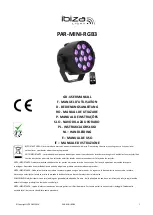
Lake Shore Model 370 AC Resistance Bridge User’s Manual
8.5 FUSE
REPLACEMENT
Use the following procedure to remove and replace the line fuses.
WARNING:
To avoid potentially lethal shocks, turn off controller and disconnect it from AC power before
performing these procedures.
CAUTION:
For continued protection against fire hazard, replace only with the same fuse type and rating
specified for the line for the line voltage selected.
NOTE:
Test fuse with an ohmmeter. Do not rely on visual inspection of fuse.
1. Locate line input assembly on the instrument rear panel. See Figure 8-2.
2. Turn power switch Off (
O
).
3. Remove instrument power cord.
4. With a small screwdriver, release the drawer holding the line voltage selector and fuses.
5. Remove and discard both existing fuses. Replace with proper Slow-Blow (time-delay) fuse ratings as follows:
100/120V 0.5A T 250 V
5
×
20 mm
220/240V 0.25A T 250 V 5
×
20 mm
6. Re-assemble line input assembly in reverse order.
7. Verify voltage indicator in the line input assembly window.
8. Connect instrument power cord.
9. Turn power switch On (
l
).
8.6 ERROR
MESSAGES
The following messages appear on the instrument display when it identifies a problem during operation. The messages
are divided into three groups. Instrument hardware messages are related to the instruments internal circuits or non-
volatile memory. If one of these messages persists after power is cycled the instrument requires repair or recalibration.
Limit messages are most often associated with over voltage conditions caused by an improperly selected resistance range
or excessive noise on the measurement leads. Paragraph 8.7 can be helpful in diagnosing these problems. If these
messages persist after the input or output is configured properly the instrument may require repair. Illegal operation
messages remind the operator when a feature is locked out or the instrument is not configured to support a feature.
Instrument Hardware
Defective NOVRAM
NOVRAM is defective and must be replaced
Invalid NOVRAM Contents NOVRAM contents are corrupt and parameter values will be reset to default.
Reoccurrence may indicate defective NOVRAM. Calibration is not affected.
Input Not Responding
Input microprocessor is not responding to main microprocessor. If the condition
persists after power is cycled the instrument must be repaired.
Instrument Uncalibrated
Calibration memory has been corrupted. Recalibration is required for accurate
measurements. See Paragraph 8.12 for calibration details.
Measurement or Compliance Limit
CS OVL
Current source overload possibly caused by a broken current source lead.
VCM OVL
Common mode overload at the first amplifier stage of the voltage input.
VDIF OVL
Overload at the differential amplifier stage of the voltage input.
VMIX OVL
Overload at the mixer (phase sensitive detector) stage of the voltage input.
R. OVER
Resistance range overload.
R. UNDER
Resistance range underload (equivalent of R. OVER in the negative direction)
normally a result of improper lead wiring.
T. OVER
Measured resistance is outside of the temperature response curve on the high
temperature end.
T. UNDER
Measured resistance is outside of the temperature response curve on the low
temperature end.
Heater Open
Temperature control heater is too large or open circuited.
Service
8-3
















































